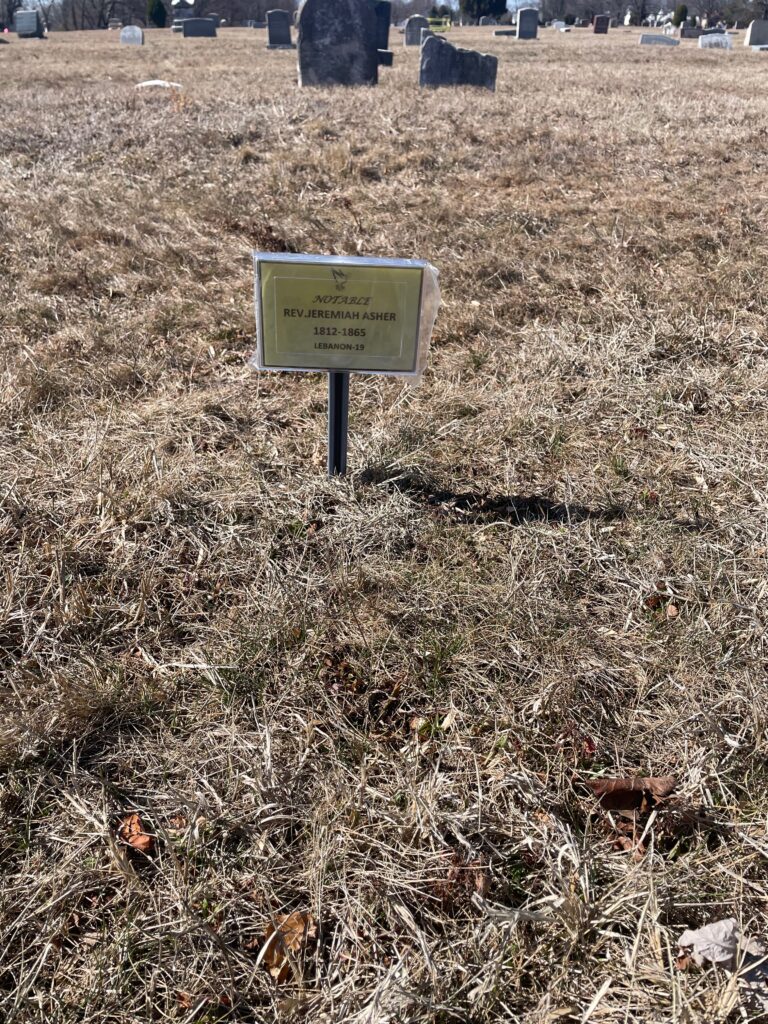Erik Visits an American Grave, Part 1,978
This is the grave of Jeremiah Asher.

Born in 1812 in North Brandford, Connecticut, Asher grew up in the free Black community in that place. His grand father was a slave taken straight from Africa who won his freedom after agreeing to fight in the American Revolution on the side of the Patriots. Far more slaves won their freedom by siding with the British. Asher married in 1830 and eventually came around to being a minister, earning an ordination in 1839. He lived and worshipped in Hartford but soon moved to Providence to start his own church. While in Rhode Island, he became one of the most prominent Black ministers in the country, leading Meeting Street Baptist Church. In 1848, he decided to go into slave territory and took a job at a church in Washington, D.C. But something happened and he only stayed a few months before moving on to a church in Philadelphia.
It turns out that Asher left that church in Hartford due to racism. See, it was an interracial church. Well, sort of. He was a Baptist. Now, this was around the time that the Baptist church was beginning to splinter because of slavery, but that’s not really the issue here and it wasn’t that the Baptists were inherently more racist than other religions. You have to erase the Southern Baptist Convention from your mind here. It was a problem in many northern Protestant churches that they might accept the idea of a church where different races worshipped together, but functionally, it was going to be segregated inside the doors. This is what Asher could not abide. Basically, this church had a Black corner. A lot of the old churches had pews with doors and things like this–you can see this is some of the old New England churches still today. Well, what the Hartford church did was basically have a Black corner. There was room for 15 or 20 people in it, but the walls were quite high, to the point that it was very difficult for parishioners to see the minister. The point of course was so that the whites didn’t actually have to see the Black parishioners. Asher was running late one morning. The box was full so he sat somewhere else. Whites freaked out. He resolved never to return to that church and he did not. While he found a Black church in Hartford, this is what spurred him to start his own church in Providence. As he wrote in 1850 about this experience, “If men disfranchise and separate me from the rest of my Father’s children, they shall do it at their own expense, not mine. I cannot prevent it, but I will not help them do it.”
In his new home, Asher became a leader in the growing community fighting for Black rights there. But what he’s known for is his work in the Civil War. His real interest was in providing ministerial services to slaves. So in 1863, he went to Yorktown, Virginia to start a church for the now freed slave communities there. He also lobbied President Lincoln to allow Black ministers to be embedded with Black troops. Lincoln agreed that this was a good idea and Asher became chaplain of the 6th U.S. Colored Troops. Overall, there were 14 Black chaplains in the military during the war, thanks largely to Asher’s lobbying.
The problem with being a minister–or really anyone near the military at all during this filthy war–is that you ended up tending to a lot of sick troops. He was in Wilmington, North Carolina at the end of the war. He was ministering to sick people and he caught typhoid. And that did it for him. He died in 1865, at the age of 52, the first Black chaplain to serve and the first Black chaplain to die in war.
Jeremiah Asher is buried in Eden Cemetery, Collingdale, Pennsylvania. Either he never had a gravestone or it was lost at some point. This cemetery, which I’ve profiled several graves from, is in the process of remembering its history and marking all the amazing people who are there, gravestones or no.
If you would like this series to visit other leading Black ministers of American history, you can donate to cover the required expenses here. Fred Shuttlesworth is in Birmingham, Alabama and James Orange is in Atlanta. Previous posts in this series are archived here and here.


